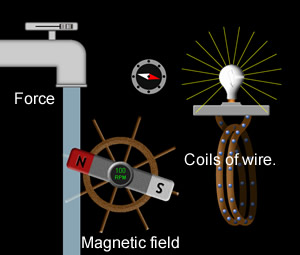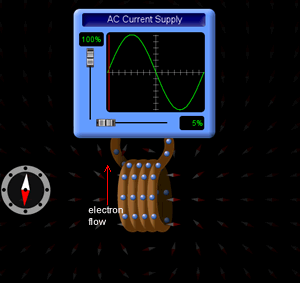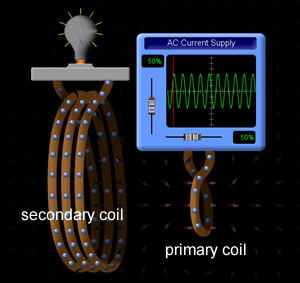On the right is an image of the generator part of the interactive animation.
What three things must a generator have to create electricity?
What can you say about the flow of electrons through the wire. Do the electrons flow in one direction? Explain.
A generator produces alternating current. Explain why this term is used.
What happens to the current when the force used to spin the magnet increases?
What happens to the current when the number of coils of wire is increased?
What happens to the current when the number of coils of wire stay the same but their size increases?
How does the magnetic field around the coils of wire change and what impact does it this change have on the electrons?

What happens when a magnet is pushed through a set of coils of wire?
Does the speed with which the magnet is pushed through have an impact on the glow of the light bulb? Explain.
Does the strength of the magnet have an influence on the brightness of the glow? Explain.

On the right is the image of the electromagnet part of the interactive animation.
What is the difference between AC and DC current?
How does the electromagnet behave with AC current as opposed to DC current?
How does the strength of the electromagnet differ as the number of coils of wire increases?

Below is some information relating to a transformer. Some new words are introduced.
A transformer is based on the fact that when an AC current flows through a wire, it generates a magnetic field commonly known as a "magnetic flux" all around it. The strength of this magnetic field is directly related to the size of the electric current and is known as the magnetic flux density. So the bigger the current the greater the magnetic flux density.
Now if another wire comes close to a wire with an AC current flowing through it , it to will experience an electric current flowing through it.

So if we put a second coil of wire next to the first one, and send a fluctuating electric current into the first coil, we will create an electric current in the second wire.
The current in the first coil is usually called the primary current and the current in the second wire is known as the secondary current.
In actual fact what happens is an electric current is passed through empty space from one coil, the primary coil, of wire to another, the secondary coil. This is called electromagnetic induction because the current in the first coil induces a current in the second coil.
On the right is an image of the transformer part of the animation. Using the interactive animation answer the questions below.
If we keep the current flowing through the primary coil constant how can the strength of the magnetic field be increased?
What happens when a DC current flows through the primary coil?
What changes when the loops of wire in the secondary coil

What is electromagnetic induction?
What is magnetic flux density?